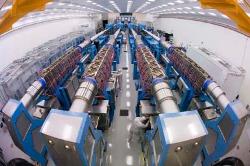Nov 3 2009
Scientists demonstrate strong laser radiation-matter coupling with intense 2.1kJ, 15ps laser pulses critical for creating and diagnosing advanced fusion plasmas
A new generation of high-energy (>kJ) petawatt (HEPW) lasers is being constructed worldwide to study high intensity laser matter interactions, including fast ignition. Fast ignition is a laser-based technique for heating and igniting deuterium and tritium fuel to fusion temperatures in a two-step process. In the first phase, laser beams vaporize a fuel pellet and compress it to a thousand times its original density, while in the second phase, electrons accelerated by an intense-laser pulse deposit energy within the fuel assembly, causing rapid heating. This is akin to the way a gasoline engine works with a spark plug.
 The OMEGA Extended Performance (EP) Laser Facility at the University of Rochester's Laboratory for Laser Energetics conducts ultrahigh-intensity laser-matter interactions research and integrated advanced-ignition experiments
The OMEGA Extended Performance (EP) Laser Facility at the University of Rochester's Laboratory for Laser Energetics conducts ultrahigh-intensity laser-matter interactions research and integrated advanced-ignition experiments
The OMEGA EP (Extended Performance) laser at the University of Rochester's Laboratory for Laser Energetics is the first of this new generation of HEPW-class lasers to be completed. OMEGA EP delivers multi-kilojoule laser energies in picosecond pulsewidths. Such high energies and short pulse durations allow significant laser powers to be produced with laser-pulse energy approaching the petawatt level – or up to a quadrillion watts.
In work that sheds new light on how to generate the powerful electron source required for fast ignition, LLE researchers have used OMEGA EP to produce intense electrical currents lasting just a few trillionths of a second. In a series of unprecedented experiments, laser energies of up to 2.1kJ were delivered to solid-density targets. These experiments represent a four-fold increase in the on-target laser energy compared to any previous petawatt-class laser system.
The LLE team used an electrostatic technique with thin-foil targets to diagnose the hot-electron source. This technique relies on copper foils no thicker than a human hair. During laser irradiation, the foils rapidly charge, similar to a capacitor plate. Within picoseconds, the majority of the laser-accelerated electrons transfer their energy to the target material. This occurs during multiple electron transits through the target – a process known as refluxing. Using this mechanism, electrons interact with the target material and generate high-energy x-rays. By diagnosing the x-ray source brightness, the conversion efficiency of laser light into energetic electrons is determined.
Using the OMEGA EP laser, constant laser-energy conversion efficiencies of around 20% and higher into energetic electrons has been demonstrated. These measurements identify what minimum fraction of intense-laser energy is available to heat the target – a critical parameter in determining the energetic and technological feasibility of full-scale fast ignition. These latest observations show that strong laser-energy coupling scales from small university-class laser systems over three orders of magnitude in laser energy to large multi-kilojoule class systems needed for fast ignition.
Achieving high conversion efficiencies with 10 to 20ps pulse durations is also paramount. The laser intensity governs the mean-electron energy. Too intense, and the energetic electrons will pass through the dense fuel and not deposit their energy in the imploded-target core. Too long, and the dense assembled fuel will decompress before it ignites. The key is to generate electrons with optimum energies while maintaining multi kilojoule laser energies to cause strong heating prior to target disassembly. Efficient production of energetic electrons with intense, 15ps long pulses at multi kilojoule laser energies as demonstrated in these experiments will allow an understanding of the requirements for full-scale fast-ignition experiments and will help define the laser requirements for future fast-ignition facilities.